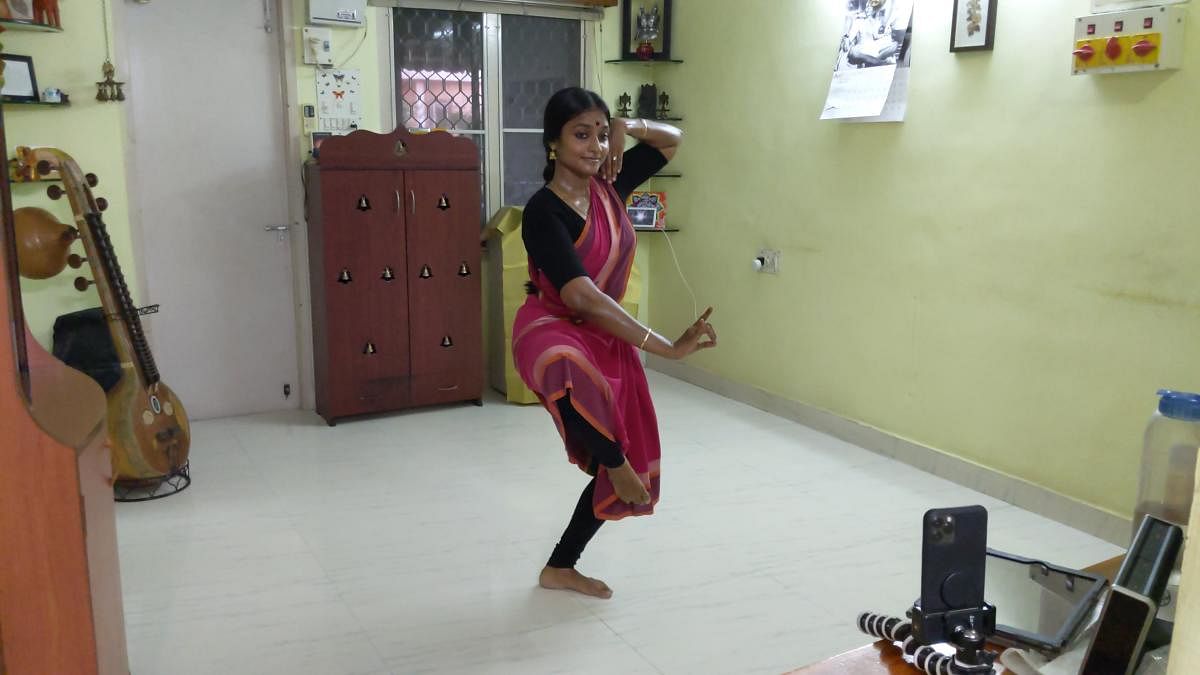
All the world’s a stage’ took on a bizarre, literal meaning in 2020. In the initial stages of the lockdown, artistes of all hues jumped onto the digital bandwagon, in an attempt to boost their morale and stay relevant. Ridden with fervour, coupled with limited logistics, some artistes have taken us into areas never seen before — bedrooms, halls, spaces in between, some strewn with unseemly articles, otherwise best hidden. What has happened to ‘Sabha lakshanam’, which demands a certain respect and propriety from both the artiste and the audience, is the question raised by many a dancer.
Senior guru, performer and choreographer Kishore Mosalikanti observes that “Online performances have converted a three-dimensional art form into a 2D format. There is no guarantee of quality. When a person comes for a stage show, he has some expectations about the performer. In an online format, the viewer is easily distracted and hits the ‘view later’ button, leaving the performer with very little audience stimulation. In a way, it teaches the performer the essence of the Bhagavad Gita — do your best with no expectation about the result.”
Missing the energy
“Dance is still best enjoyed with the ‘felt’ quality of the dancer and the audience. Its pedagogy thrives on face-to-face conversations and learning,” says senior Bharatanatyam exponent Vidhya Subramaniam.
Shobha Korambil, senior Kuchipudi dancer and co-ordinator for Sridevi Nrithyalaya, says that Sheela Unnikrishnan has decided that her students will not perform on a digital platform as there is no perceivable benefit, monetary or otherwise. This feeling is not exclusive to the classical art form alone. Singer, songwriter Orlando Ambrose of the Medium Rare Band, feels that “digitally, one cannot transfer feelings and emotions through a screen, since art requires interpersonal reciprocity and synergy between the band and the audience.”
Vijay Krishnan, a lead guitarist and recording artiste, also feels that “unlike theatre releases being converted to OTT portals, an audience can’t find online performances as captivating and compelling as live shows.” Jitesh James Dharmaraj, songwriter and bass guitarist with four leading bands, emphasises that “online shows lack the charm and energy of a gig, where the artiste and the audience feed off each other.”
Artistes soon discovered that while their online presence grew exponentially, their remuneration did not match. This is the holiday season during which, in a normal year, many musicians earn a big chunk of their online income; instead, many are spending their meagre savings to buy expensive equipment to do online shows and classes that do not benefit them monetarily.
A time to introspect
This is echoed by classical artistes who are busiest in the months leading to the Margazhi festival, but are now forced to explore other viable avenues for income. A majority have also missed out on lucrative tours abroad, owing to the closure of global borders. Online event organisers have mushroomed overnight in an attempt to piggyback on the artistes fan-following for their own financial gains. Most established artistes have taken a step back from free “fundraiser” performances, which have now become an overkill with negligible returns on investment of time and efforts, even in terms of personal branding. Much like the commodities market, middlemen thrive on their digital reach by cannibalising on established names, which is the reason many institutes like the Sridevi Nrithyalaya, have chosen to organise their own exclusive shows, thus protecting their monetary interests.
Many senior artistes have otherwise used this time to introspect, re-work choreographies, ideate, experiment, create and cross-learn to up-sell themselves. This has led to a surge of content-creation online. Renjith and Vijna, the popular Bharatanatyam duo, emphasise the need for professional artistes like themselves, for whom dance is bread and butter, to use content for social media in a sensible, responsible manner and to be sensitive to other artistes who collaborate. On the same lines, Varsha Venkatesh, Yoga coach of Yoga Vriksha, warns that now more than ever, artistes should know their true worth and strive to add value to content, instead of falling prey to the glamour of instant viral fame.
Faced with little choice, even the hitherto traditional sabhas, who have looked down on pre- recorded dance music in their pristine halls, are now forced to embrace pre-recorded shows, or live-streams with tickets. They have come a long way; to adapt from buzzing kutcheris to buzzing cell phones. The response to this year’s Margazhi season — devoid of ethnic attire in the front rows, the animated make-or-mar exchanges in canteens and the accompanying pomp and glory — remains to be seen. While most artistes are still struggling to comprehend the digital medium, Sandhya Raju, actress and an established Kuchipudi dancer with the most incredulous fan following on YouTube, has an interesting observation to make. “The benchmark for online success is the number of views an artiste receives. The playing field may seem levelled in the current scenario, because it is as yet disorganised. It will re-organise like sabhas and become a proper platform with proper channels, proper subscribers and stronger competition. Cross-sharing and celebrity shout-outs will become the norm, with a mix of talent and agenda-driven content.”
Stage shows will always stay relevant and successful, but possibly will become more niche and demand a higher standard of excellence. The way forward is definitely digital. All artistes are in agreement that although visual arts are always best experienced ‘live’, as time becomes more exclusive and online platforms more accessible, the shift, at least to some extent, would be inevitable. In short, ‘Subscribe, Like and Share’ is here to stay!